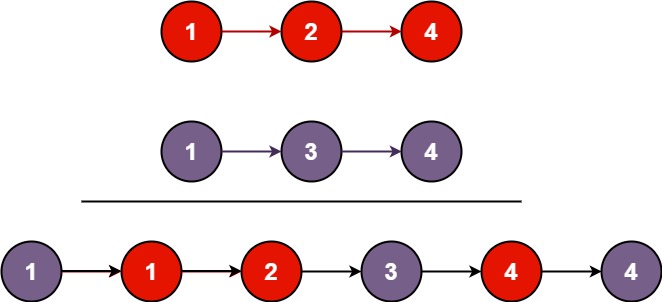1. Rotate Image by 90 Degrees In-Place
You are given an n x n 2D matrix representing an image, rotate the image by 90 degrees (clockwise).
You have to rotate the image in-place, which means you have to modify the input 2D matrix directly. DO NOT allocate another 2D matrix and do the rotation.
Example 1:

Input: matrix = [[1,2,3],[4,5,6],[7,8,9]] Output: [[7,4,1],[8,5,2],[9,6,3]]
Example 2:

Input: matrix = [[5,1,9,11],[2,4,8,10],[13,3,6,7],[15,14,12,16]] Output: [[15,13,2,5],[14,3,4,1],[12,6,8,9],[16,7,10,11]]
Constraints:
- n == matrix.length == matrix[i].length
- 1 <= n <= 20
- -1000 <= matrix[i][j] <= 1000
2. Merge Two Sorted Linked Lists
You are given the heads of two sorted linked lists list1 and list2.
Merge the two lists in a one sorted list. The list should be made by splicing together the nodes of the first two lists.
Return the head of the merged linked list.
Example 1:

Input: list1 = [1,2,4], list2 = [1,3,4] Output: [1,1,2,3,4,4]
Example 2:
Input: list1 = [], list2 = [] Output: []
Example 3:
Input: list1 = [], list2 = [0] Output: [0]
Constraints:
- The number of nodes in both lists is in the range [0, 50].
- -100 <= Node.val <= 100
- Both list1 and list2 are sorted in non-decreasing order.
3. House Robber Problem
You are a professional robber planning to rob houses along a street. Each house has a certain amount of money stashed, the only constraint stopping you from robbing each of them is that adjacent houses have security systems connected and it will automatically contact the police if two adjacent houses were broken into on the same night.
Given an integer array nums representing the amount of money of each house, return the maximum amount of money you can rob tonight without alerting the police.
Example 1:
Input: nums = [1,2,3,1] Output: 4 Explanation: Rob house 1 (money = 1) and then rob house 3 (money = 3). Total amount you can rob = 1 + 3 = 4.
Example 2:
Input: nums = [2,7,9,3,1] Output: 12 Explanation: Rob house 1 (money = 2), rob house 3 (money = 9) and rob house 5 (money = 1). Total amount you can rob = 2 + 9 + 1 = 12.
Constraints:
- 1 <= nums.length <= 100
- 0 <= nums[i] <= 400
4. Finding Missing Numbers in Array
Given an array nums of n integers where nums[i] is in the range [1, n], return an array of all the integers in the range [1, n] that do not appear in nums.
Example 1:
Input: nums = [4,3,2,7,8,2,3,1] Output: [5,6]
Example 2:
Input: nums = [1,1] Output: [2]
Constraints:
- n == nums.length
- 1 <= n <= 105
- 1 <= nums[i] <= n
Follow up: Could you do it without extra space and in O(n) runtime? You may assume the returned list does not count as extra space.
5. Decode String with Nested Repetitions
Given an encoded string, return its decoded string.
The encoding rule is: k[encoded_string], where the encoded_string inside the square brackets is being repeated exactly k times. Note that k is guaranteed to be a positive integer.
You may assume that the input string is always valid; there are no extra white spaces, square brackets are well-formed, etc. Furthermore, you may assume that the original data does not contain any digits and that digits are only for those repeat numbers, k. For example, there will not be input like 3a or 2[4].
The test cases are generated so that the length of the output will never exceed 105.
Example 1:
Input: s = "3[a]2[bc]" Output: "aaabcbc"
Example 2:
Input: s = "3[a2[c]]" Output: "accaccacc"
Example 3:
Input: s = "2[abc]3[cd]ef" Output: "abcabccdcdcdef"
Constraints:
- 1 <= s.length <= 30
- s consists of lowercase English letters, digits, and square brackets '[]'.
- s is guaranteed to be a valid input.
- All the integers in s are in the range [1, 300].


